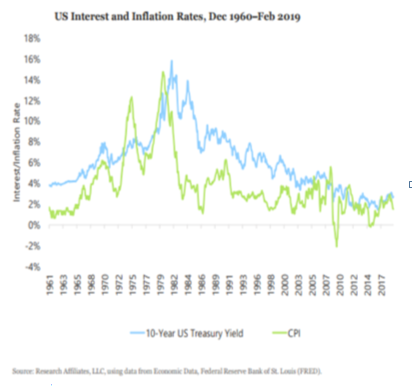There has been significant discussion recently to define or redefine the role of central banks and the objective of monetary policy. This post great recession definition is being labeled as Modern Monetary Theory (MMT). MMT makes the case that central banks should respond to growing government programs and economic demands by aggressively printing money, unconstrained by tax receipts and borrowing. If MMT succeeds in adoption, the impact to markets is meaningful. Investors may anticipate growing, high, and/or volatile inflation. This scenario hinders savers and investors alike because real returns in stocks and bonds become muted. The chart below from Research Affiliates shows the relationship between the 10 year treasury interest rate and inflation (CPI) dating back to 1961. Historically, the money supply has served to reign in inflation. The future may show the opposite to be true, also.
Modern Monetary Theory

- Far left leaning politicians gravitate towards MMT because it allows increased spending on social programs with less emphasis on raising taxes to fund the programs.
- MMT makes the case to its advocates that the theory has the ability to decrease wealth inequality by bringing the lower and middle class more in line with the upper class through government programs.
- Stagflation may also occur, historically providing less than favorable market returns.
